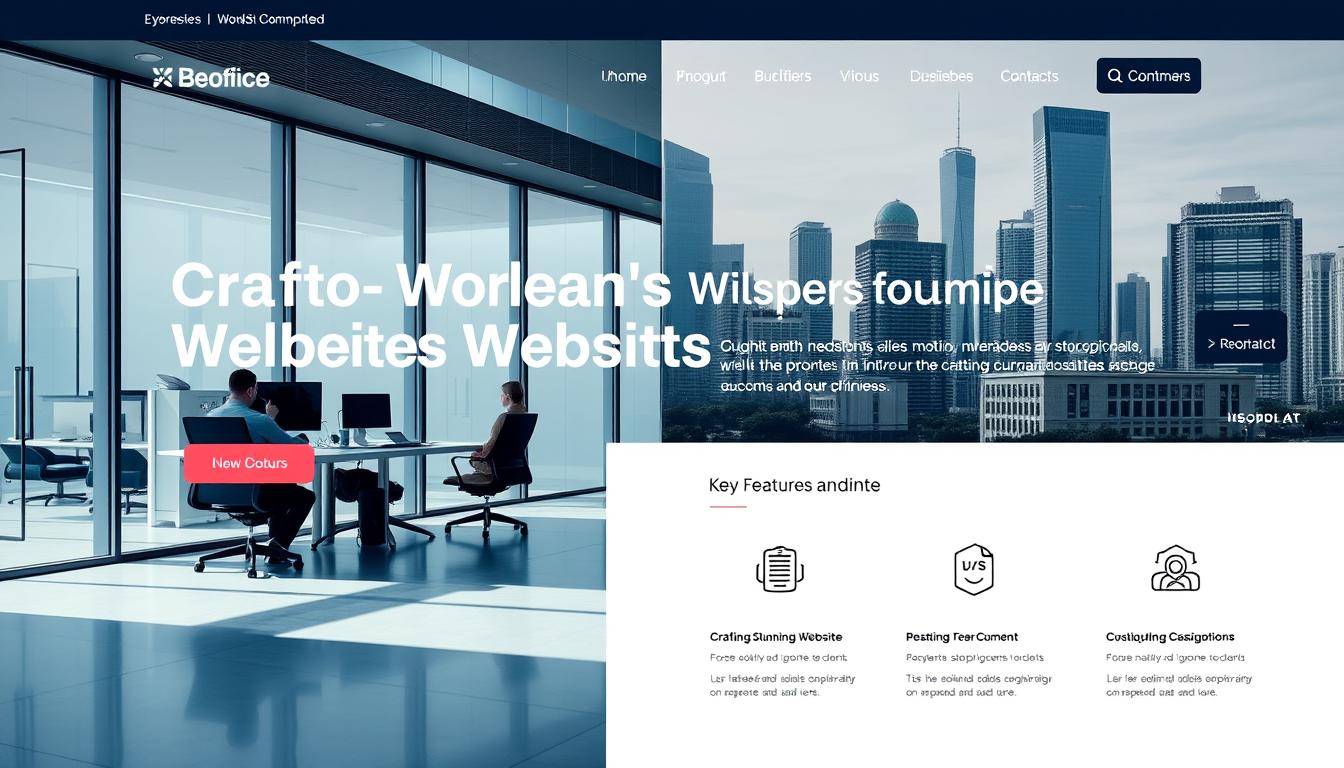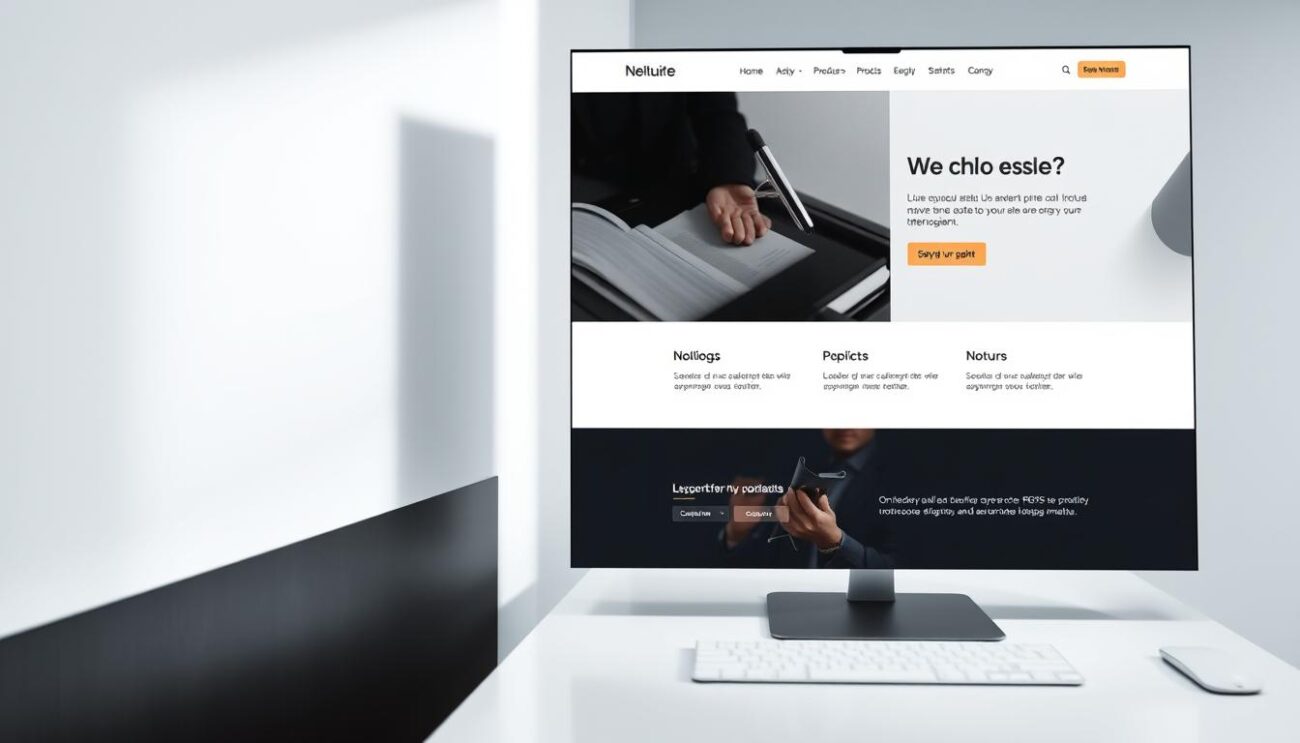In today’s digital landscape, a professional website is no longer a luxury but a necessity for businesses. With the majority of consumers turning to the internet to find products and services, a well-crafted online presence is crucial.
A responsive web design can significantly boost business growth by increasing customer trust and improving conversion rates. According to a study, a well-designed business website can achieve just that, making it an essential tool for any business looking to expand its online presence.
Key Takeaways
- A professional website is crucial for business growth.
- Responsive web design improves customer trust.
- A well-designed business website boosts conversion rates.
- Having a business website is no longer a luxury but a necessity.
- A professional online presence is key to business success.
The Power of First Impressions: Why Your Business Website Matters
As the digital face of your company, your website plays a pivotal role in shaping customer perceptions and driving business success. In today’s digital landscape, a business website is often the first point of contact between a company and its potential customers, making it a crucial element in creating a lasting impression.
The Digital Storefront: How Websites Represent Your Brand
Your website serves as the digital storefront of your business, representing your brand’s values, mission, and unique selling propositions. A well-designed website can effectively communicate your brand’s identity, fostering trust and credibility with your target audience. According to a study by Stanford University, 75% of users judge a company’s credibility based on its website.
User Experience and Its Impact on Conversion Rates
The user experience (UX) on your website significantly influences conversion rates. A seamless and intuitive UX design can lead to higher engagement, increased customer satisfaction, and ultimately, improved conversion rates. Key elements of effective UX design include:
- Clear navigation and information architecture
- Responsive design for various devices
- Fast loading speeds
The Cost of Poor Design: Statistics and Facts
A poorly designed website can have detrimental effects on your business, leading to lost sales, decreased customer engagement, and a negative brand image. Statistics show that:
- 40% of users will abandon a website that takes more than 3 seconds to load.
- 88% of online consumers are less likely to return to a site after a bad experience.
Investing in a well-designed website is crucial for businesses aiming to thrive in the digital marketplace.
Essential Elements of Effective Website Design
Effective website design is more than just aesthetics; it’s about creating a seamless user experience. A well-crafted website can significantly enhance user engagement, drive conversions, and ultimately boost business growth. By focusing on key design elements, businesses can create a website that not only looks great but also functions intuitively.
Visual Appeal: Colors, Typography, and Imagery
The visual appeal of a website is crucial in capturing users’ attention. Colors, typography, and imagery play a significant role in creating an engaging and aesthetically pleasing design. For instance, choosing the right color scheme can evoke emotions and convey the brand’s message. Typography is equally important, as it affects readability and can influence how users perceive the brand.
Functionality and Navigation: Creating Intuitive User Journeys
A website’s functionality and navigation are critical components of User Experience. An intuitive design ensures that users can easily find what they’re looking for, reducing bounce rates and increasing engagement. By streamlining navigation and making key information readily accessible, businesses can create a user-friendly website that drives conversions.
“A mobile-responsive website is crucial for a good user experience, as more than 50% of internet users access websites through mobile devices.” – [Credible source]
Mobile Responsiveness: Designing for All Devices
Responsive Web Design is no longer a luxury but a necessity. With the majority of internet users accessing websites through mobile devices, a mobile-responsive design ensures that a website looks and functions great across all devices. By incorporating Responsive Web Design principles, businesses can provide a consistent and engaging user experience, regardless of how users access their site.
In conclusion, effective website design is a multifaceted concept that encompasses Visual Appeal, functionality, and mobile responsiveness. By prioritizing these elements, businesses can create a website that not only attracts users but also drives conversions and fosters growth.
Professional Website Design Services: What to Expect
In today’s digital landscape, a professionally designed website is no longer a luxury, but a necessity. As businesses increasingly rely on their online presence to attract and retain customers, the demand for professional website design services has skyrocketed.
When considering professional website design services, one of the primary decisions you’ll face is choosing between custom website design and template-based solutions. A study by a credible source found that e-commerce websites with custom designs have higher conversion rates compared to those using template-based solutions. This is because custom designs are tailored to your business’s unique needs, enhancing user experience and ultimately driving more sales.
Custom Website Design vs. Template-Based Solutions
Custom website design offers a bespoke approach, allowing for greater flexibility and creativity in representing your brand. On the other hand, template-based solutions are more budget-friendly and quicker to implement but may lack the uniqueness and personal touch that custom designs offer.
E-commerce Website Development and Integration
For businesses looking to sell products or services online, e-commerce website development is crucial. This involves not only creating an online store but also integrating various payment gateways, managing inventory, and ensuring a seamless user experience. Effective e-commerce solutions can significantly boost sales and customer satisfaction.
Content Management Systems and Their Benefits
A Content Management System (CMS) is a vital tool for managing and updating your website’s content without needing extensive technical knowledge. CMS platforms like WordPress, Joomla, and Drupal offer flexibility, scalability, and a range of plugins and themes to enhance your site’s functionality and appearance.
Ongoing Maintenance and Support Services
Once your website is launched, ongoing maintenance and support services are essential to keep it secure, updated, and performing optimally. This includes regular software updates, security monitoring, and technical support to address any issues promptly.
By understanding what to expect from professional website design services, businesses can make informed decisions that drive their online success. Whether it’s through custom website design, e-commerce development, or leveraging the benefits of a CMS, a well-designed website is a powerful tool for growth and customer engagement.
The Website Design Process: From Concept to Launch
Launching a successful website requires a meticulous design process that transforms concepts into reality. According to a credible source, a well-planned website design process can reduce the risk of project delays and cost overruns. This process is multifaceted, involving several stages that work together to create a website that meets business goals and user expectations.
Discovery and Planning
The initial stage of the website design process is discovery and planning. This phase involves understanding the business goals, target audience, and market trends. It’s a critical step that lays the foundation for the entire project. During this stage, designers and developers work closely with clients to gather information, define project scope, and establish clear objectives.
Key activities during discovery and planning include:
- Conducting stakeholder interviews
- Analyzing competitors
- Defining the target audience and user personas
- Outlining the site’s structure and content strategy
Wireframing and Prototyping
Once the planning stage is complete, the next step is wireframing and prototyping. Wireframing involves creating a visual representation of the website’s layout and functionality, while prototyping takes it a step further by creating an interactive model. This stage is crucial for visualizing the website’s structure and user flow.

Wireframing and prototyping allow designers to test and refine the website’s usability and navigation before moving to the development phase.
Design and Development
The design and development stage brings the wireframes and prototypes to life. This involves creating the visual design elements, such as colors, typography, and imagery, and then developing the website using appropriate technologies. The goal is to create a website that is not only visually appealing but also functional and responsive.
Key considerations during design and development include:
- Ensuring cross-browser compatibility
- Optimizing for mobile devices
- Implementing accessibility features
- Integrating content management systems (CMS)
Testing and Launch
The final stage before launch is testing. This involves checking the website for usability, performance, and compatibility issues. Testing ensures that the website provides a smooth user experience and meets the defined objectives. After thorough testing, the website is launched, making it available to the public.
A successful launch is the culmination of a well-executed website design process, resulting in a website that effectively supports business goals.
How Strategic Website Design Transforms Business Growth
In today’s digital landscape, a strategic website design can be a game-changer for businesses. A well-designed website is not just about aesthetics; it’s about creating a digital experience that drives business growth.
Increased Credibility and Trust Among Customers
A strategic website design can significantly enhance a business’s credibility and trust among its customers. According to a study by Stanford University, 75% of users admit to making judgments about a company’s credibility based on its website. A well-designed website can instill trust and make a positive first impression, which is crucial for converting visitors into customers.
Credibility is built when a website is professional, easy to navigate, and provides clear information. This, in turn, fosters trust among users, making them more likely to engage with the business.
Enhanced User Engagement and Retention Metrics
Strategic website design also focuses on enhancing user engagement and retention metrics. By creating an intuitive and user-friendly interface, businesses can keep visitors engaged for longer periods. This can be achieved through various design elements, such as clear calls-to-action, minimalistic design, and fast loading speeds.
Enhanced user engagement leads to better retention metrics, as users are more likely to return to a website that provides a positive experience. This can result in increased brand loyalty and ultimately drive business growth.
Improved Conversion Rates and Measurable ROI
One of the key benefits of strategic website design is the potential for improved conversion rates. By optimizing the website’s design and layout, businesses can guide visitors through the sales funnel more effectively. This can include strategies such as A/B testing, clear calls-to-action, and streamlined checkout processes.
The result is a measurable return on investment (ROI) that can be tracked and analyzed. By monitoring conversion rates and other key metrics, businesses can refine their website design to continually improve performance.
Current Trends in Website Design for 2023 and Beyond
In 2023, the focus of website design is on creating immersive, responsive, and personalized user experiences. As technology advances and user behaviors evolve, businesses must stay abreast of the latest trends to remain competitive.
Minimalist Design and Micro-interactions
Minimalist design continues to gain traction, with clean layouts and subtle animations enhancing user engagement. Micro-interactions, such as hover effects and loading animations, add a layer of sophistication to websites, making them more interactive and enjoyable to navigate.
Dark Mode and Accessibility Features
Dark mode has become a staple in modern website design, offering users a visually comfortable experience, especially in low-light environments. Moreover, incorporating accessibility features ensures that websites are usable by everyone, including people with disabilities. This not only broadens the audience but also reflects a brand’s commitment to inclusivity.
AI-Powered Personalization and Chatbots
The integration of AI-powered personalization allows websites to tailor content and recommendations based on user behavior and preferences. Chatbots, powered by AI, provide instant customer support, improving user satisfaction and reducing bounce rates.
Voice User Interface and Search Optimization
With the rise of voice assistants, optimizing websites for voice search is becoming crucial. This involves using natural language keywords and ensuring that the website’s structure is easily crawlable by search engines, thereby improving visibility and accessibility.
By embracing these trends, businesses can create websites that are not only visually appealing but also highly functional and user-friendly, ultimately driving engagement and conversion.
Selecting the Right Website Design Partner for Your Business
In the competitive world of online business, partnering with the right website design company can be a game-changer. Your website is often the first point of contact with potential customers, making it a crucial element in your marketing strategy. Therefore, it’s essential to choose a design partner that understands your business goals and can deliver a website that meets your needs.
Questions to Ask Potential Website Designers
Before committing to a website design company, it’s vital to ask the right questions. These should include inquiries about their design process, experience with similar businesses, and how they measure the success of their projects. By doing so, you can gauge their expertise and ensure they align with your business objectives.
- What is your design process, and how do you involve clients in the decision-making process?
- Can you share examples of previous work and the results achieved for your clients?
- How do you stay up-to-date with the latest web design trends and technologies?
Evaluating Portfolios and Case Studies
A reputable website design company will have a comprehensive portfolio that showcases their work. When evaluating portfolios, look for designs that are visually appealing, user-friendly, and align with your brand identity. Case studies can also provide valuable insights into their problem-solving abilities and the impact of their designs on clients’ businesses.
Understanding Pricing Models and Timeline Expectations
Different pricing models can significantly affect your budget. It’s crucial to understand whether the company charges hourly, project-based, or retainer-based fees. Additionally, clarifying timeline expectations can help you plan for the launch of your website and ensure that it meets your business needs.
By carefully considering these factors and choosing a website design partner that aligns with your goals, you can create a website that not only looks great but also drives results for your business.
Success Stories: Businesses Transformed by Professional Website Design
Professional website design has the power to transform businesses, as seen in numerous success stories across various industries. A well-designed website is more than just a digital presence; it’s a powerful tool that can drive business growth, enhance customer engagement, and boost sales.

Small Business Case Study: Local Retail to Online Success
A local retail store in the United States was struggling to compete with online giants. By investing in professional website design, they were able to expand their customer base beyond geographical limitations. Their online sales increased by 50% within the first six months, demonstrating the potential of e-commerce integration for small businesses.
Service Industry Example: Streamlining Client Acquisition
A service-based company revamped their website with a focus on user experience and intuitive navigation. This strategic redesign led to a 30% increase in client inquiries, showcasing the importance of effective website design in streamlining client acquisition processes.
E-commerce Transformation: Boosting Sales Through Strategic Design
An e-commerce business transformed their online store by implementing a responsive design and enhancing their product pages. According to a case study by a credible source, this led to a significant increase in sales and revenue. The business saw a 25% boost in conversion rates, highlighting the impact of strategic website design on e-commerce success.
These success stories underscore the importance of professional website design in driving business transformation. By investing in a well-designed website, businesses can achieve significant growth, improve customer engagement, and increase sales.
“A well-designed website is crucial for business success in today’s digital landscape.”
— Expert in Digital Marketing
Conclusion: Investing in Your Digital Future
As businesses continue to navigate the digital landscape, a well-designed website remains a crucial element in driving growth and success. By investing in professional website design, companies can establish a strong online presence, foster customer trust, and ultimately boost conversion rates.
According to a credible source, businesses that invest in their digital presence are more likely to achieve long-term success. A professional website design not only enhances user experience but also provides a competitive edge in the market. By prioritizing Investing in Digital Future, businesses can reap the benefits of Professional Website Design and drive Business Growth.
In today’s digital age, a website is no longer just a digital storefront; it’s a vital tool for businesses to connect with their audience and achieve their goals. By making a strategic investment in website design, companies can set themselves up for success and stay ahead of the competition.


